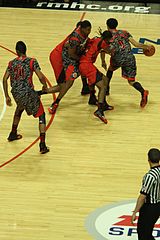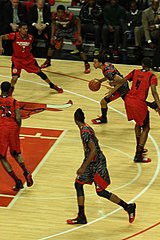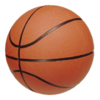| Revision as of 05:43, 13 July 2021 edit2601:580:c201:1950:15d:b3d9:ba5d:ac71 (talk) Added more details to offensive and defensive options off of screens.Tags: Reverted Mobile edit Mobile web edit← Previous edit |
Latest revision as of 22:14, 5 November 2024 edit undoPol098 (talk | contribs)Extended confirmed users, Pending changes reviewers118,919 edits {{Refimprove|date=November 2024}} |
| (9 intermediate revisions by 7 users not shown) |
| Line 1: |
Line 1: |
|
|
{{Short description|Blocking move in team sports}} |
| ⚫ |
{{See also|Screen pass}} |
|
|
|
|
|
|
|
{{Refimprove|date=November 2024}} |
|
{{multiple image |
|
{{multiple image |
|
| align = right |
|
| align = right |
| Line 24: |
Line 25: |
|
| header_align = <!-- left/right/center --> |
|
| header_align = <!-- left/right/center --> |
|
| header_background = |
|
| header_background = |
|
| footer = After ] sets a pick on ] for ], that breaks Williams-Goss free for a drive down the lane at the ] |
|
| footer = After ] sets a pick on ] for ], that breaks Williams-Goss free for a drive down the lane at the ] |
|
| footer_align = <!-- left/right/center --> |
|
| footer_align = <!-- left/right/center --> |
|
| footer_background = |
|
| footer_background = |
| Line 30: |
Line 31: |
|
}} |
|
}} |
|
|
|
|
|
A '''screen''' is a blocking move by an offensive player in which they stand beside or behind a defender in order to free a teammate to either shoot a pass or drive in to score. In ] and ], it is also known as a '''pick'''. Screens can be on-ball (when set for the ball-handler), or off-ball (when set for a teammate moving without the ball to get open for a pass). The two offensive players involved in setting the screen are known as the ''screener'' (who blocks the defender) and the ''cutter'' (who gets free from the defender). |
|
A '''screen''' in ]s is a blocking move by an offensive player in which they stand beside or behind a defender in order to free up a teammate to shoot, pass, or drive the ball in to score. In ] and ], it is also known as a ''']'''. Screens can be on-ball (when set for the ball-handler), or off-ball (when set for a teammate moving without the ball to get open for a pass). The two offensive players involved in setting the screen are known as the ''screener'' (who blocks the defender) and the ''cutter'' (who gets free from the defender). |
|
|
|
|
|
Successfully "setting a screen" in ] such as ] and ] requires attention to position and timing. An offensive player will first establish position so that his teammate can move toward him. The teammate changes pace and direction, and ''cuts'' (moves or dribbles quickly) very close to the screening player. The defender who is covering the cutter will have to push into the screening player, or divert around, losing a few steps. In basketball and lacrosse, the offensive player setting the pick must remain stationary at the moment of contact with the defender, and allow the defensive player a "reasonable opportunity" to avoid the screen; a screen is illegal if the screener moves in order to make contact, and obtains an advantage; the result is an offensive foul in basketball and a ] in lacrosse. There must be illegal contact for a moving screen to be a foul; no illegal contact, no foul, no matter how much moving the screener does. If the screener holds, leans or moves into the defender to cause contact, this will result in a foul on the screener. |
|
Successfully "setting a screen" in ] such as ] and ] requires attention to position and timing. An offensive player will first establish position so that a teammate can move toward them. The teammate changes pace and direction, and ''cuts'' (moves or dribbles quickly) very close to the screening player. The defender who is covering the cutter will have to push into the screening player, or divert around, losing a few steps. In basketball and lacrosse, the offensive player setting the pick must remain stationary at the moment of contact with the defender, and allow the defensive player a "reasonable opportunity" to avoid the screen; a screen is illegal if the screener moves in order to make contact, and obtains an advantage; the result is an offensive foul in basketball and a ] in lacrosse. There must be illegal contact for a moving screen to be a foul; no illegal contact, no foul, no matter how much moving the screener does. If the screener holds, leans or moves into the defender to cause contact, this will result in a foul on the screener. |
|
|
|
|
|
] and ] for Chris Walker at the ].]] |
|
] and ] for Chris Walker at the ].]] |
|
|
|
|
|
After setting the screen, the screener is often open to roll to the basket and receive a pass. This tactic is called ] in basketball. Another basketball tactic, called the ], is for the ballhandler to drive to the basket while the screener squares for a jumpshot. Commonly, the ball handler will use the ball screen to simply confuse and bluff the defense and instead reject the screen, going the short way around the screener penetrating to the hoop. |
|
After setting the screen, the screener is often open to roll to the basket and receive a pass. This tactic is called ] in basketball. Another basketball tactic, called the ], is for the ballhandler to drive to the basket while the screener squares for a jumpshot. |
|
|
|
|
|
Defensive moves to defeat a screen include sliding behind the pick if the screening player leaves space, fighting over and in front of the screen to stay close to the ball handler (pushing the screener away, where allowed—this is not allowed in basketball), if the defender is strong enough. Switching defensive assignments with a defender of a similar height is an increasingly popular defensive option. That defender can pick up coverage of the cutter on the other side of the screen. Pre-switching a developing screen off-ball is also a popular defensive option in order to better match the heights of the switching defenders and avoid mismatches in the builds of the two players defending the screener and ball handler. In the NBA and other higher levels of play, the defender of the screening player is often instructed to "hedge" the screen and switch, meaning they aggressively cut off the future path of the ball handler prior to their cut (on the far side of the basket) and prepare to switch defensive assignments if the screen is used. Rejecting the screen after the defense has already committed to a hedge is a popular and effective counter to this tactic since it can confuse the player defending the ball handler, who was already preparing to switch their defensive coverage onto the screener. |
|
Defensive moves to defeat a screen include sliding by the pick if the screening player leaves space, fighting over the screen (pushing the screener away, where allowed—this is not allowed in basketball), if the defender is strong enough, or switching defensive assignments with another defender, who can pick up the cutter on the other side of the screen. |
|
|
|
|
|
In the team sport ] setting a screen is not allowed.<ref>{{cite web|title=WFDF Rules of Ultimate 2013|url=http://www.wfdf.org/about/meeting-minutes/doc_download/20-rules-of-ultimate|publisher=World Flying Disc Federation|access-date=9 November 2014}}</ref> The screened player can call "pick", whereupon the play stops with all other players holding their current positions. The screened player can now catch up to the offensive player he or she was defending, then play continues. |
|
In the team sport ] setting a screen is not allowed.<ref>{{cite web|title=WFDF Rules of Ultimate 2013|url=http://www.wfdf.org/about/meeting-minutes/doc_download/20-rules-of-ultimate|publisher=World Flying Disc Federation|access-date=9 November 2014}}</ref> The screened player can call "pick", whereupon the play stops with all other players holding their current positions. The screened player returns to defend the offensive player he or she was defending and then play continues. |
|
|
|
|
|
== See also == |
|
== See also == |
|
⚫ |
* ] |
|
|
* ] |
|
* ] |
|
* ] |
|
* ] |
|
* ] |
After setting the screen, the screener is often open to roll to the basket and receive a pass. This tactic is called pick and roll in basketball. Another basketball tactic, called the pick and pop, is for the ballhandler to drive to the basket while the screener squares for a jumpshot.
Defensive moves to defeat a screen include sliding by the pick if the screening player leaves space, fighting over the screen (pushing the screener away, where allowed—this is not allowed in basketball), if the defender is strong enough, or switching defensive assignments with another defender, who can pick up the cutter on the other side of the screen.


 After Jarell Martin sets a pick on Cat Barber for Nigel Williams-Goss, that breaks Williams-Goss free for a drive down the lane at the 2013 McDonald's All-American Boys Game
After Jarell Martin sets a pick on Cat Barber for Nigel Williams-Goss, that breaks Williams-Goss free for a drive down the lane at the 2013 McDonald's All-American Boys Game

